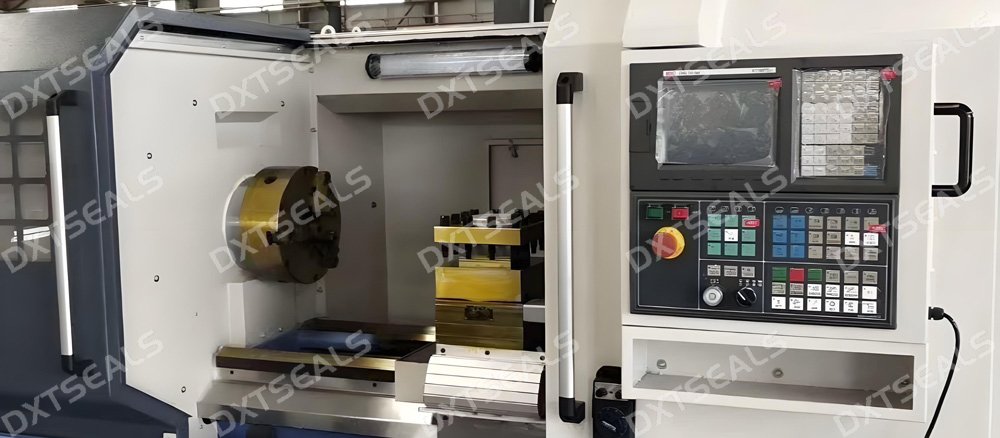Introduction
Seal rings are essential components used in a variety of industries, including automotive, aerospace, oil and gas, and manufacturing. Their primary function is to prevent the leakage of fluids or gases, and they must meet high standards of precision, durability, and performance. One of the critical factors in producing high-quality seal rings is the machining process, which ensures that the seals fit perfectly and perform optimally under various conditions.
In this article, we will explore the different machining methods used to create seal rings, such as CNC machining, turning, and grinding, and discuss their applications in different industries.
1. CNC Machining for Seal Rings
CNC (Computer Numerical Control) machining is one of the most widely used methods for producing precision seal rings. It involves using computer-controlled machines to remove material from a solid workpiece, such as metal or plastic, to create the desired seal shape. This method is ideal for producing complex geometries and achieving high accuracy in the final product.
Applications of CNC Machining for Seal Rings
- Aerospace: CNC machining is used to produce high-performance seals for aircraft engines, fuel systems, and hydraulic systems, where precision and reliability are critical.
- Oil and Gas: High-pressure and high-temperature seal rings used in drilling and pipeline systems are often machined using CNC technology for their strength and precision.
- Automotive: CNC machining is employed for producing seals used in engine components, transmissions, and braking systems, ensuring they withstand high stresses and maintain performance.
Benefits of CNC Machining
- High precision and accuracy with tight tolerances.
- Customizable designs to meet specific sealing requirements.
- Versatility in materials such as metals, plastics, and composites.
- Ideal for low-to-medium volume production.
2. Turning for Seal Ring Production
Turning is another essential machining method used for producing seal rings, particularly those with cylindrical shapes. In this process, the workpiece is rotated while a cutting tool removes material to shape the seal ring. Turning is suitable for producing simple to moderately complex sealing rings with smooth surfaces and consistent dimensions.
Applications of Turning for Seal Rings
- Hydraulic Systems: Seal rings for hydraulic cylinders, pumps, and valves are commonly produced using turning to ensure a tight seal and reliable fluid control.
- Automotive Industry: Turning is used for producing seals that are essential for automotive applications, including engine seals and transmission seals.
- Manufacturing: Turning is used for producing sealing rings for machinery used in manufacturing processes, including rotary seals for motors and compressors.
Benefits of Turning
- Efficient production for cylindrical seals with smooth finishes.
- Capable of producing high-precision components with tight tolerances.
- Cost-effective for small-to-medium production runs.
3. Grinding for Seal Ring Finishing
Grinding is typically used as a finishing process to achieve a smooth, precise surface on seal rings. It involves using an abrasive wheel to remove material from the workpiece, creating a fine surface finish. Grinding is often performed after turning or other machining methods to enhance the surface quality of the seal ring and ensure it meets the required specifications for sealing efficiency.
Applications of Grinding for Seal Rings
- High-performance seals: Grinding is often used in industries such as aerospace and automotive, where high-performance seals are required to meet strict tolerance and surface finish requirements.
- Oil and Gas: Seals used in drilling operations and pressure systems are ground to ensure a smooth, tight fit that prevents leakage under extreme conditions.
- Precision Sealing: Seals used in pumps, compressors, and other machinery are often ground to provide superior sealing properties and longevity.
Benefits of Grinding
- Enhanced surface finish for improved sealing performance.
- Precision control over tolerances and surface quality.
- Ideal for finishing high-precision components with complex shapes.
4. Other Machining Methods for Seal Rings
In addition to CNC machining, turning, and grinding, several other machining methods can be used to produce seal rings, depending on the material and application requirements.
a. Milling
Milling involves using rotating cutters to remove material from a workpiece. This method is suitable for creating seals with more complex geometries or intricate features, such as grooves or holes for lubrication.
b. Electrical Discharge Machining (EDM)
EDM is used for materials that are hard to machine with traditional methods. It uses electrical discharges to remove material, making it ideal for producing seals from hard metals or alloys.
c. Laser Cutting
Laser cutting uses high-powered lasers to cut through materials with great precision. This method is often used for cutting seals from thin materials or for creating intricate, detailed designs.
5. Choosing the Right Machining Method for Your Seal Rings
When selecting a machining method for seal ring production, several factors need to be considered, including the material of the seal ring, the required precision, the complexity of the design, and the production volume.
Factors to Consider:
- Material type: Some materials, such as metals and composites, may require CNC machining or grinding for precise results, while softer materials like rubber may be suitable for simpler machining methods like turning or die cutting.
- Precision and tolerances: CNC machining is ideal for applications that require high precision, while turning and grinding are used for producing seals with smooth surfaces and tight tolerances.
- Production volume: CNC machining is great for low-to-medium volume runs, while turning and grinding can be more cost-effective for high-volume production.
Conclusion
The machining methods used to produce seal rings significantly impact their performance, durability, and suitability for different applications. From CNC machining for precision and customization to turning for efficient production and grinding for surface finishing, each method offers distinct advantages depending on the material and intended use.
By choosing the right machining method for your seal ring production, you can ensure that your seals perform reliably in their intended environments, whether in aerospace, automotive, oil and gas, or industrial machinery.

